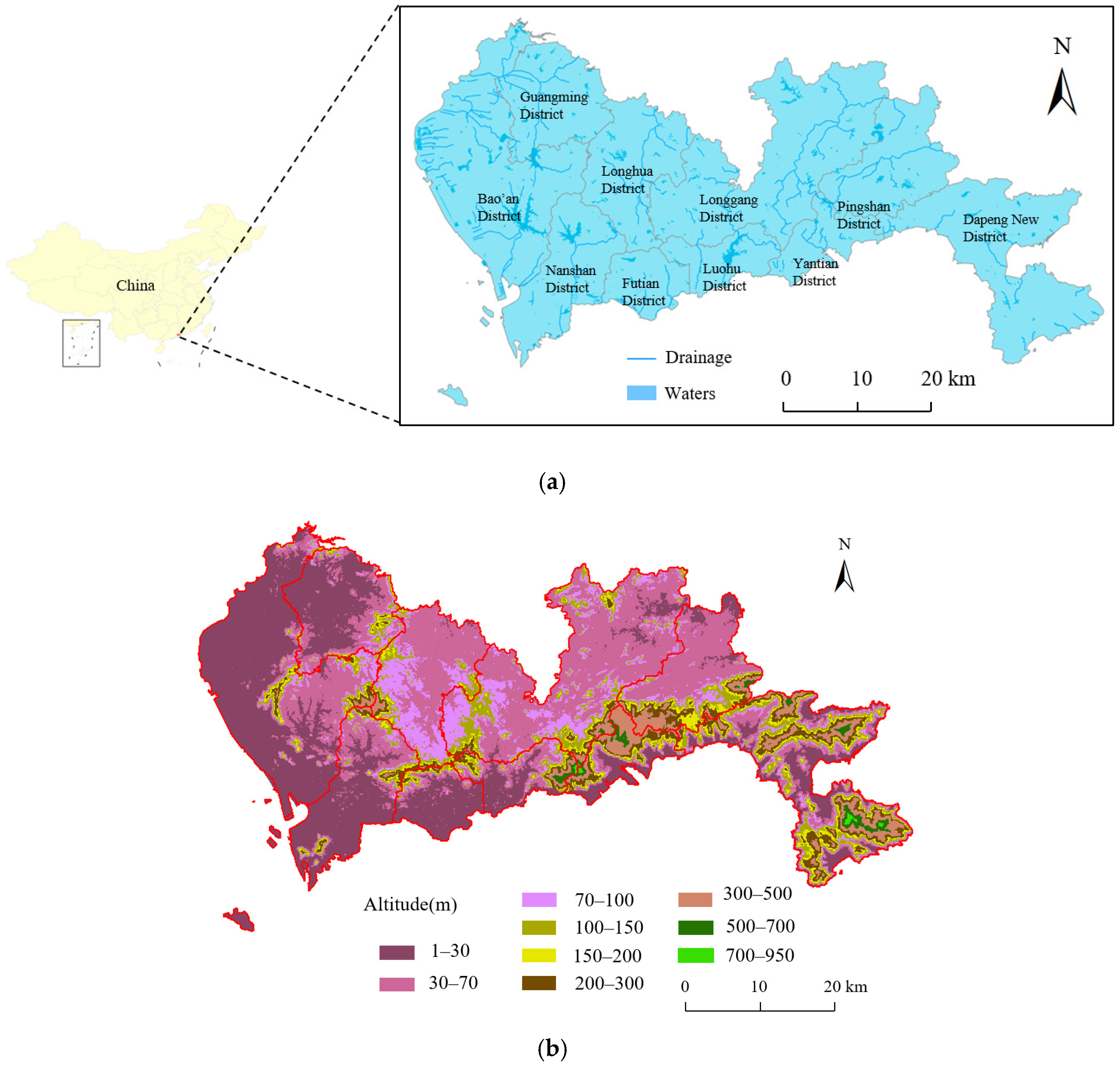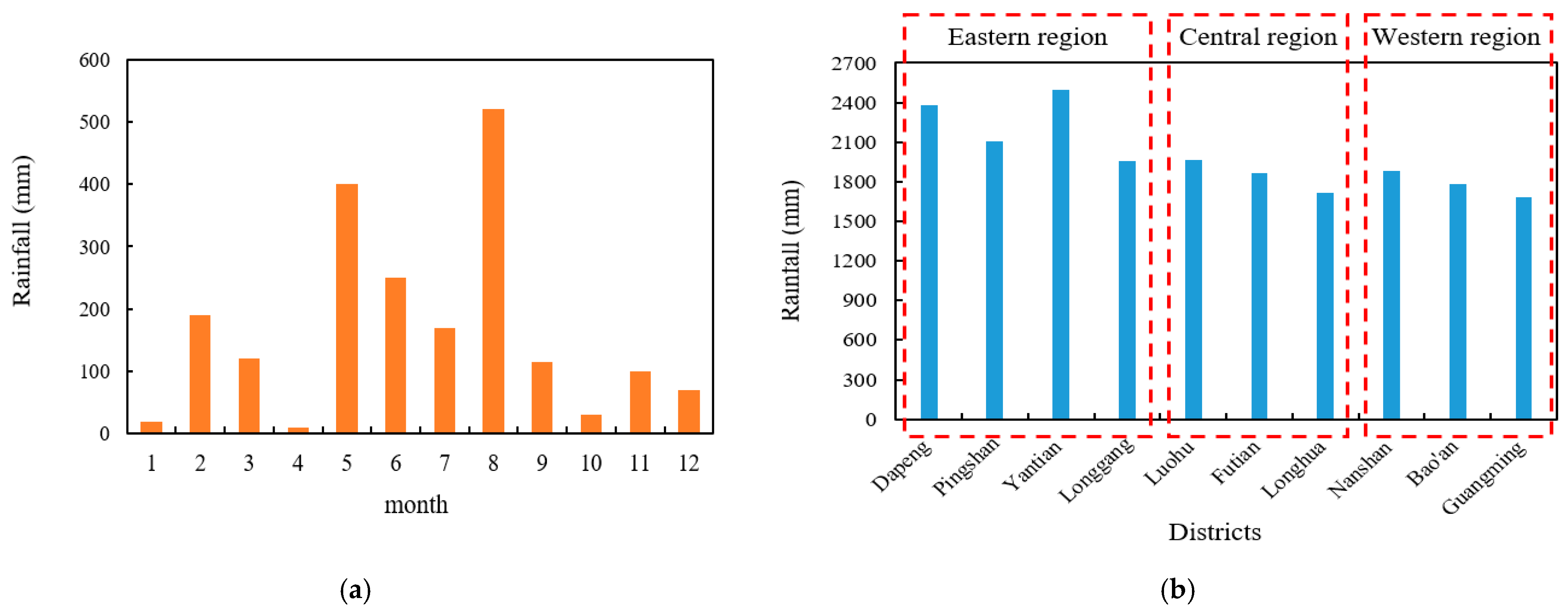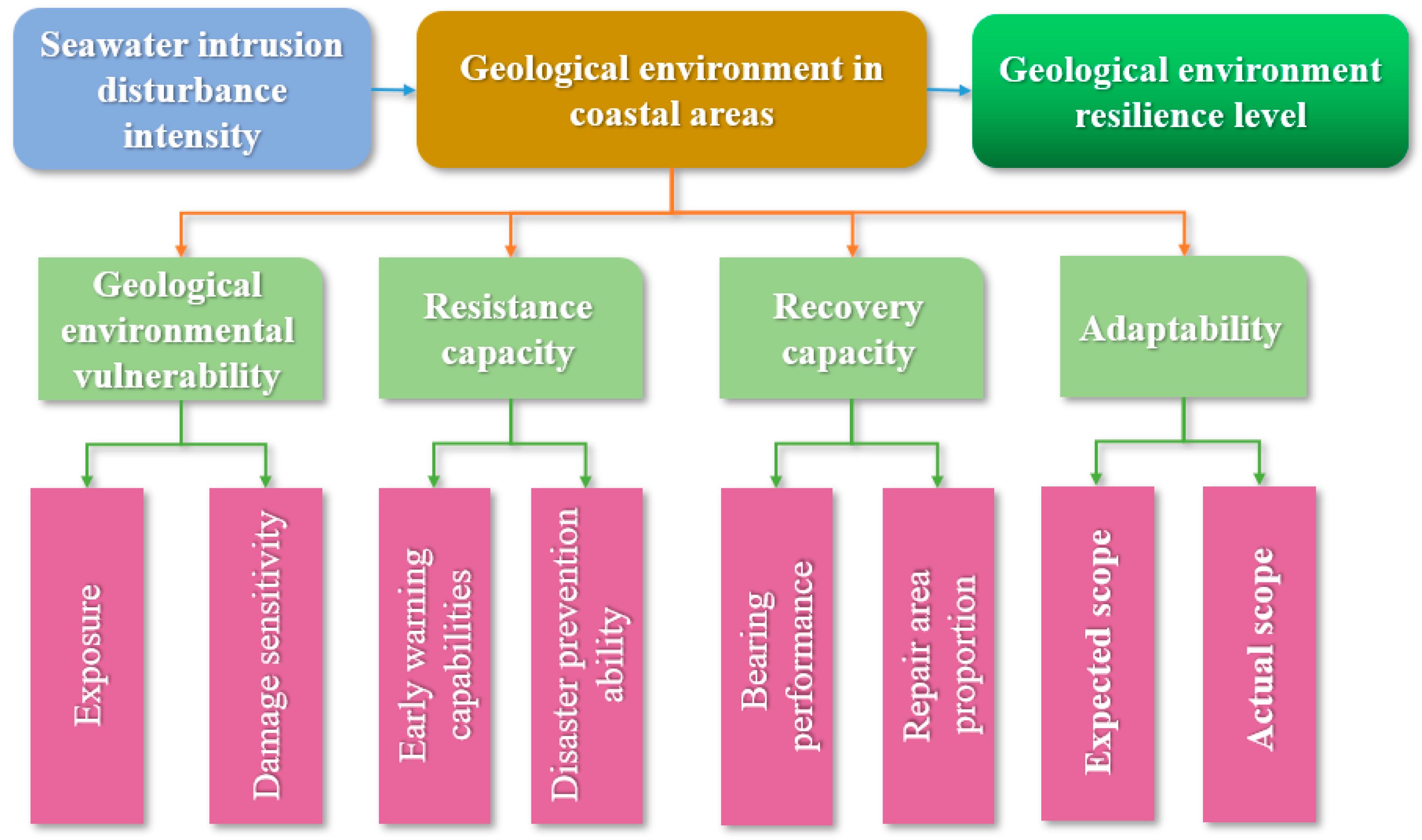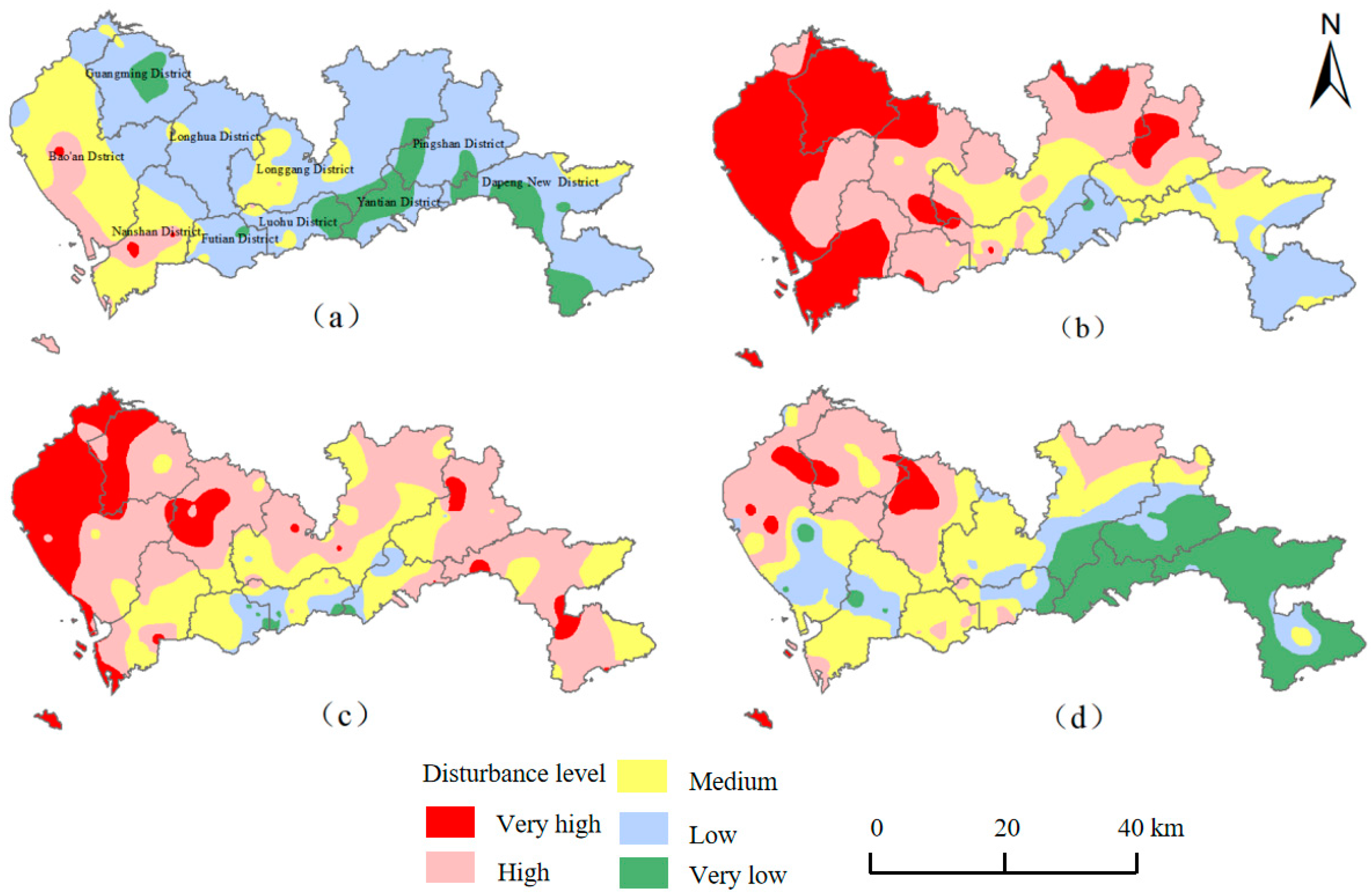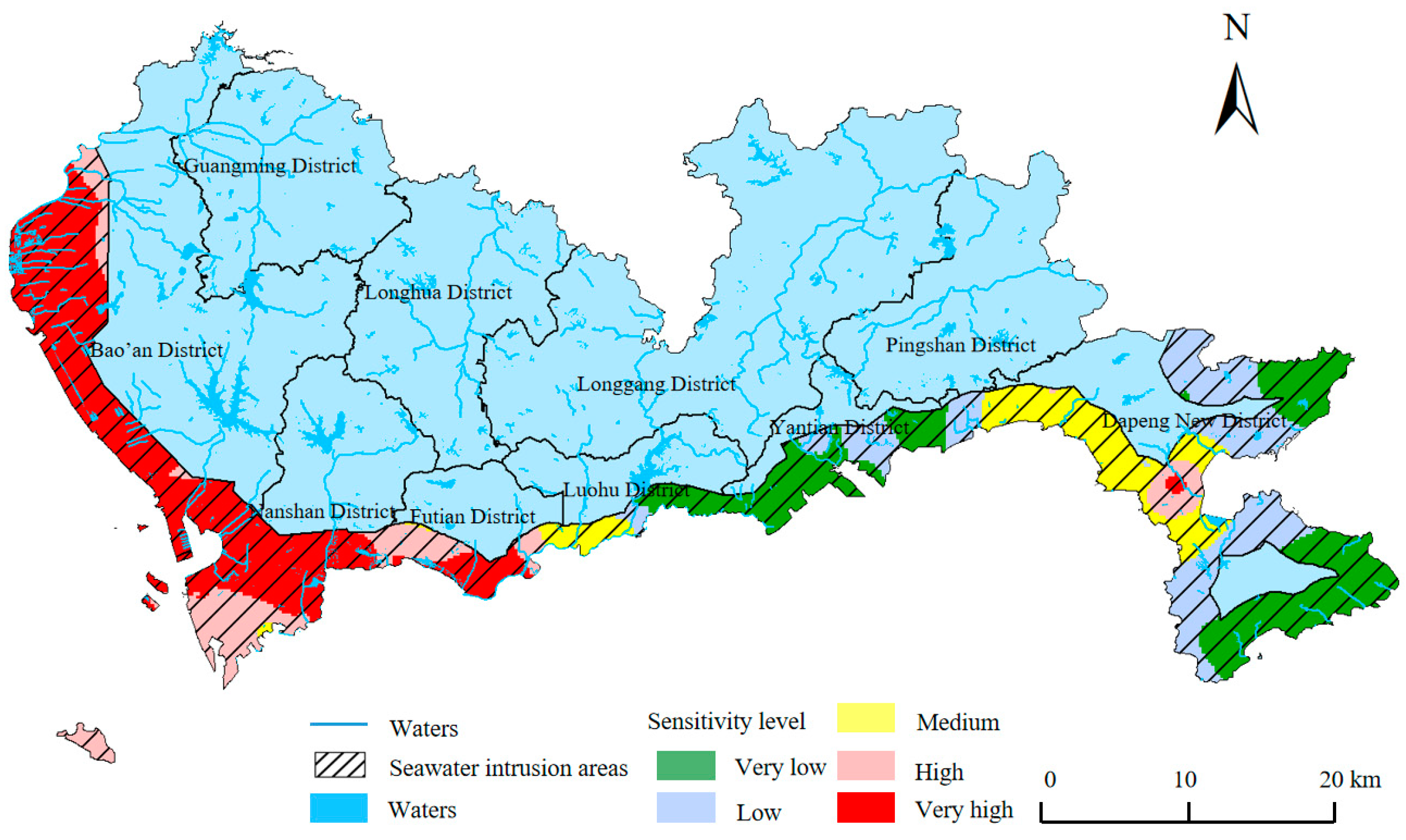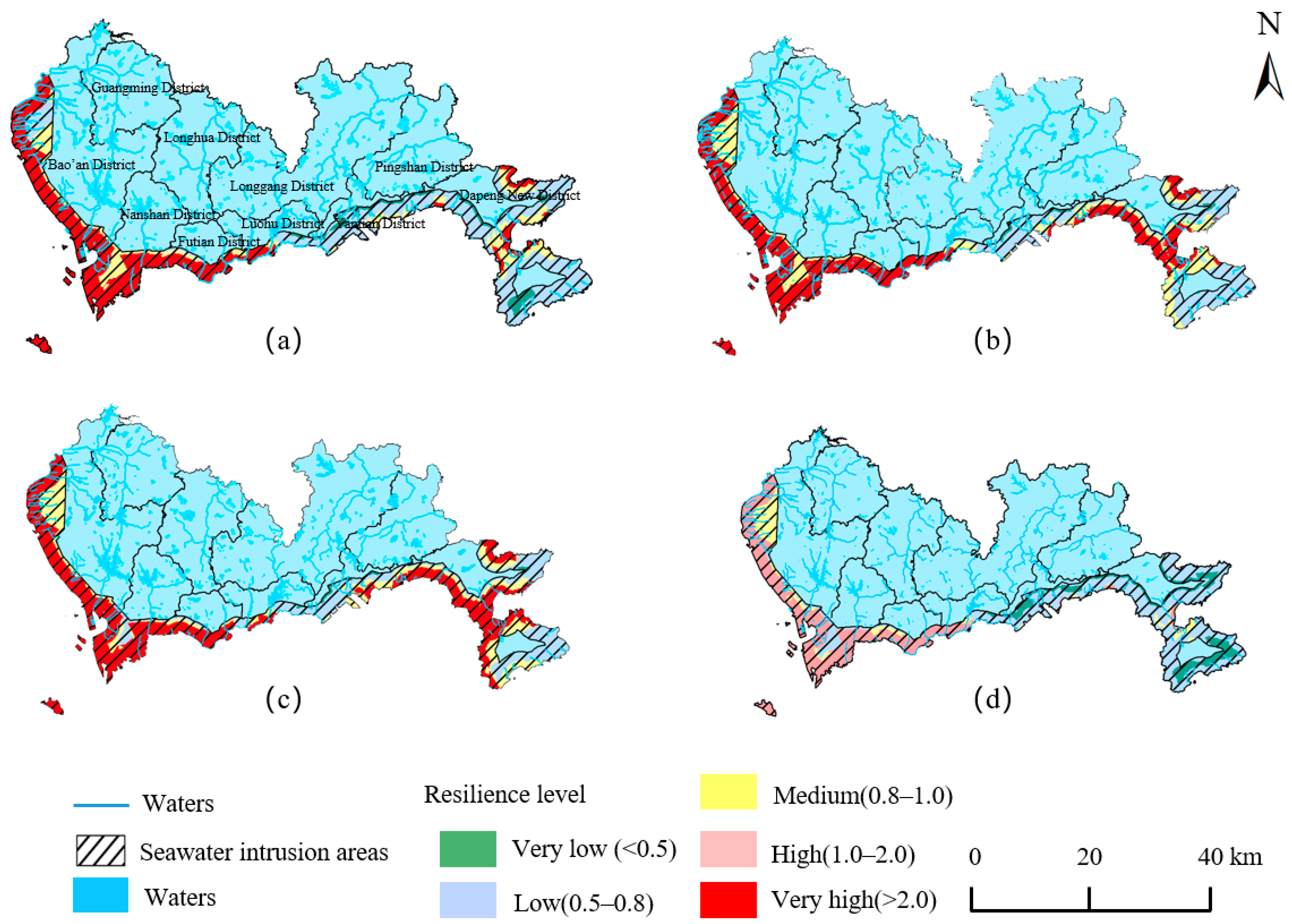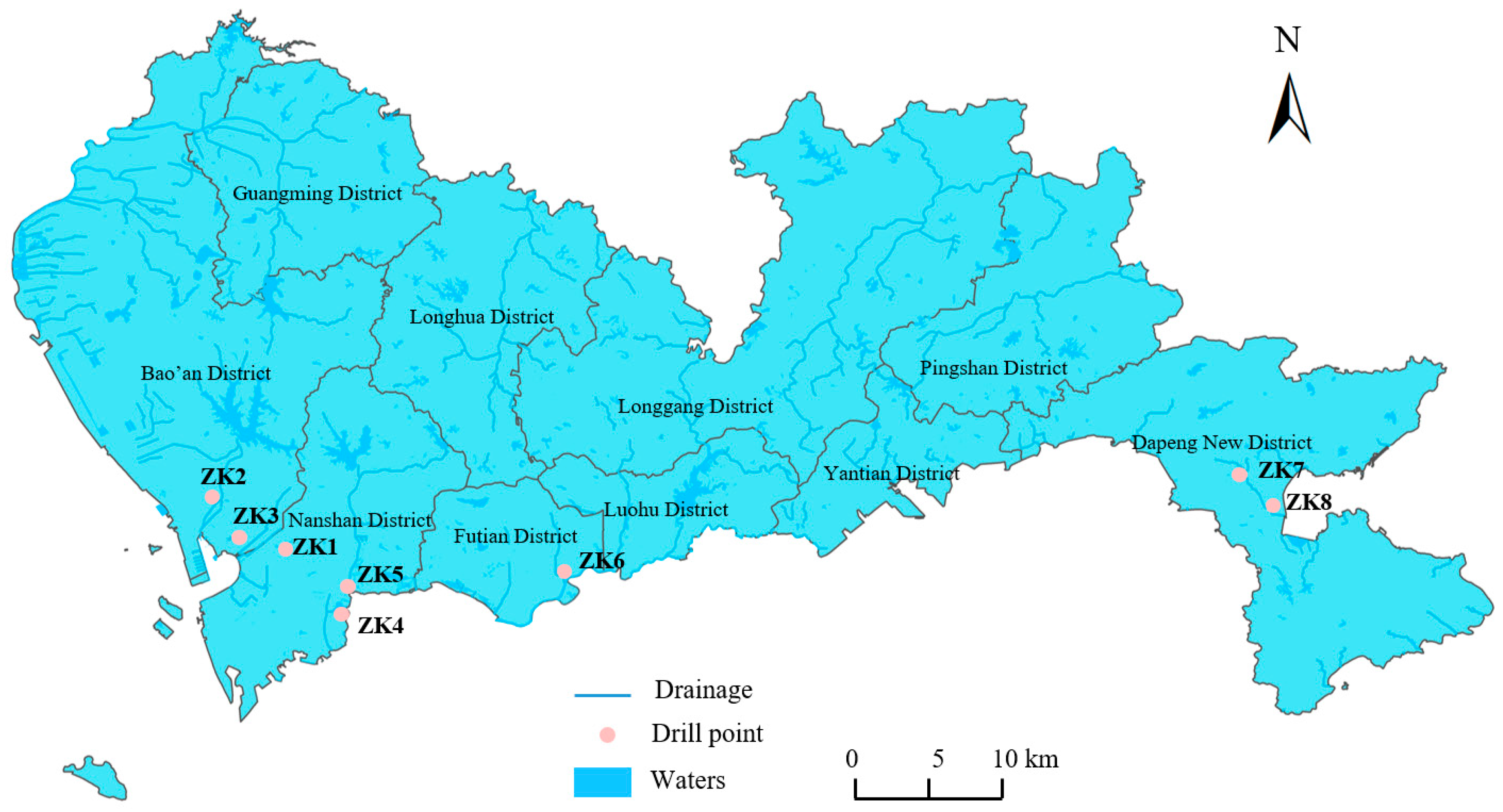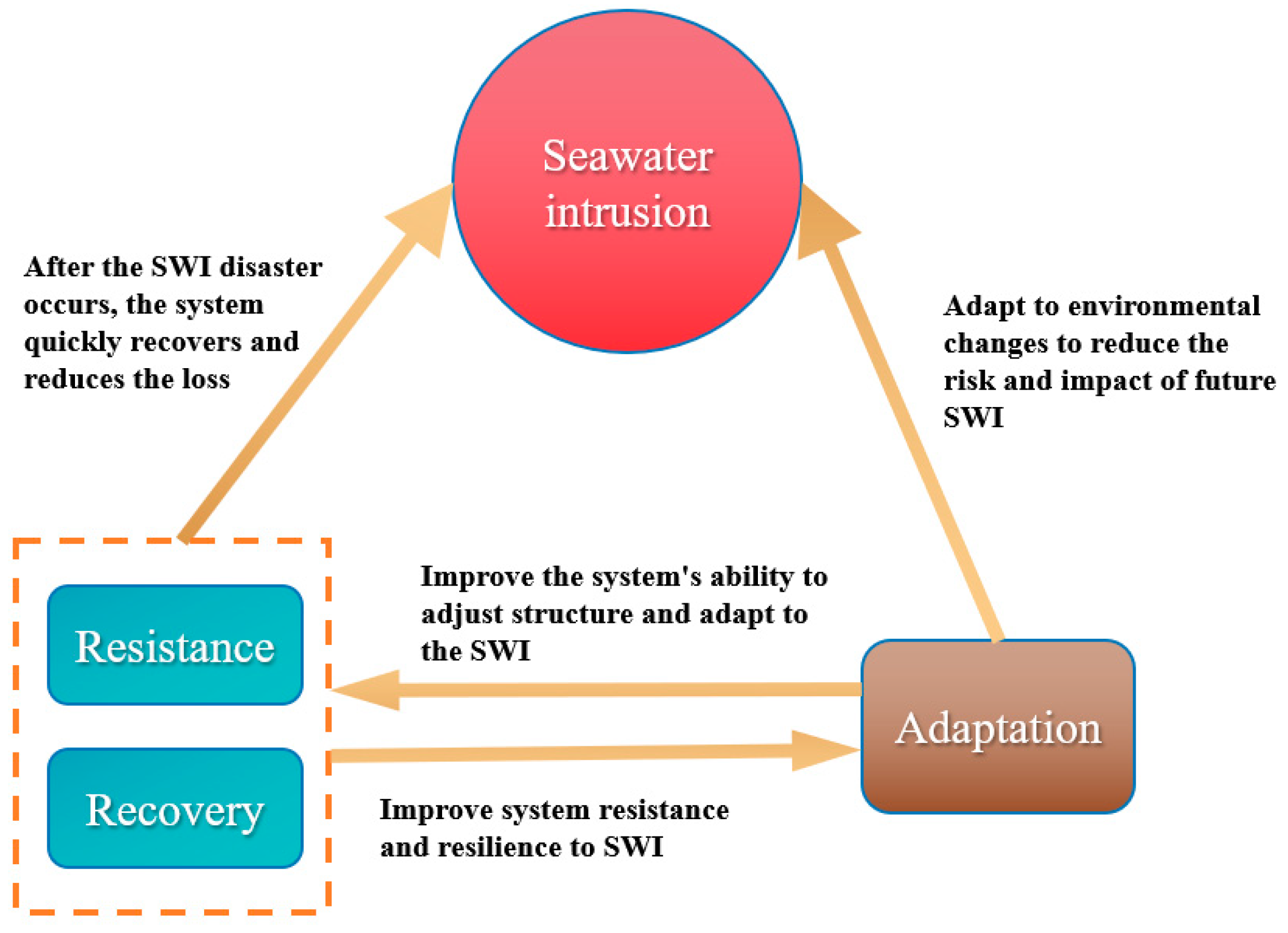1. Introduction
Seawater intrusion (SWI) is a severe global geological hazard facing coastal areas. It can damage the ecological [
1] and geological environment [
2] and affect local biodiversity [
3]. As one of the geological hazards coastal cities frequently face, SWI is complex, including global climate change [
4,
5], geological conditions [
6,
7], groundwater flow direction [
8], and human activities [
7,
9]. Excessive groundwater extraction [
10], overdevelopment of coastal areas, coastal engineering projects, and oil and gas exploration can contribute to SWI. SWI degrades groundwater quality [
11,
12,
13] and leads to freshwater scarcity [
14], significantly impacting local industries such as agriculture [
15], fisheries, and tourism.
Many researchers have made significant progress in studying the impact of natural conditions and human activities on SWI hazards. They used numerical simulations, experimental simulations, and hydro-chemical analysis to determine the temporal variation, extent, and depth of SWI. For instance, researchers utilized a three-dimensional hydrodynamic model to simulate the blocked and confined seawater intrusion in coastal lagoons, revealing the spatiotemporal evolution of seawater intrusion and its mixing efficiency with lagoon water [
16]. In other studies, the effects of sea-level rise on seawater intrusion in layered aquifers were simulated using SEAWAT and sharp-interface models [
17]. Hydrogeochemical methods and enveloping analysis based on lake measurement data were employed to investigate the characteristics and potential risks of seawater intrusion in coastal cities in southern China [
18]. The degree of seawater intrusion was determined by assessing the Na/Cl ratio in groundwater samples through chemical analysis [
19]. Geophysical measurements, core drilling, and groundwater chemical analysis have been utilized to determine the spatial extent and degree of SWI affecting groundwater in various regions, including the western Nile Delta area [
20], the Thermaikos Bay, eastern Greece [
21], the town of Buzhuang, and southwest of Laizhou Bay, China [
22]. Countries have developed a series of measures to cope with seawater intrusion, including rational exploitation of groundwater, land use planning, groundwater monitoring and the construction of anti-seepage walls, which have played a certain role in reducing seawater intrusion [
23].
Scholars primarily use sensitivity and vulnerability analyses to assess the extent of damage caused by SWI to the geological environment and groundwater. These assessments provide valuable insights for managing and preventing SWI. A comprehensive groundwater pollution risk assessment method is proposed for the Beijing Plain, integrating inherent vulnerability, pollution sources, and groundwater functional zoning to determine the levels of groundwater pollution risk [
24]. Vulnerability assessment models are developed and applied to analyze vulnerability based on groundwater data from Jeju volcanic island and Beihai city, followed by classification based on the assessment results [
25,
26]. To address the vulnerability of coastal aquifers in northern Greece to SWI, an improved fuzzy multicriteria decision-making approach is proposed, resulting in the development of preventive strategies such as aquifer recharge and optimization of pumping efficiency based on the assessment outcomes [
27]. In evaluating the risk of SWI in the Eastern Mediterranean coastal aquifer, the quantitative analysis of interactions among natural, anthropogenic, and climate-driven factors is conducted, along with a comprehensive analysis of strengths, weaknesses, opportunities, and threats [
28].
Numerous valuable insights are amassed in the analysis of the causes of seawater intrusion, the evaluation of its severity, and the formulation of prevention and control strategies. However, while there have been some achievements in the risk assessment of the geological environment caused by SWI, research on the geological environment resilience (GER) to SWI is not sufficiently explored, with most studies focusing on sensitivity and vulnerability analyses. Because Shenzhen is a coastal city, has a flat terrain and serious seawater erosion, is economically developed and densely populated, and has extensive use of underground space, studying this problem is of significance for protecting the underground space. Therefore, this study takes Shenzhen city as an example. Based on the three basic requirements of robustness, recoverability, and adaptability, we evaluate the geological environment resilience under the influence of SWI by assessing the disturbance factors, vulnerability, resistance capacity, recovery capacity, and adaptability. This study will help to better understand the impact of SWI on the geological environment in coastal areas and provide reference for the prevention and control of seawater intrusion and the protection of underground freshwater resources.
5. Discussion
5.1. Disturbance Intensity
According to climate bulletins for Shenzhen from 2019 to 2022 and the annual distribution of rainfall (
Figure 11), the western coastal area experienced a sharp decrease in precipitation in 2020 and 2021, leading to insufficient groundwater replenishment and the migration of the salt–freshwater interface toward the freshwater area, making it easier for seawater to intrude into the land. Therefore, the disturbance intensity in this area was high to relatively high. However, the disturbance intensity in the eastern coastal area was moderate to moderately high. In 2019 and 2022, there was sufficient rainfall, especially in 2022, which resulted in the disturbance intensity of SWI in the western coastal area being moderate, whereas the disturbance intensity in the eastern coastal area was low because sufficient rainfall can replenish freshwater and push the salt–freshwater interface toward the seawater area, reducing the degree of SWI.
The freshwater area will be invaded by seawater while the salt–freshwater interface in underground water moves toward the freshwater area. Conversely, when the interface moves toward the seawater area, it indicates that the freshwater resource has been replenished. Many natural and human factors can affect the salt–freshwater interface in underground water and the occurrence of SWI. Natural factors include storm surges, seawater upstream along river channels, and global-warming-induced sea-level rise. Human activities include groundwater extraction, high-altitude seawater aquaculture, and the construction of reservoirs upstream of rivers. In the 1980s to 1990s, due to the need for economic development, blind groundwater extraction in Shenzhen caused a drop in water levels and high-altitude seawater aquaculture, leading to severe SWI. After entering the 21st century, in order to protect the environment and promote high-quality economic development, measures such as prohibiting groundwater exploitation, transforming the water intake channels and aquaculture areas of high-altitude mariculture into anti-seepage channels and ponds, and carrying out seawater desalination and salt removal work have, to a certain extent, protected the freshwater resources of groundwater. The infiltration of atmospheric precipitation replenishes underground freshwater, promotes the movement of the salt–freshwater interface toward the seawater area, and prevents SWI.
Therefore, this article concludes that groundwater extraction and high-altitude seawater aquaculture are no longer the primary disturbing factors causing SWI in Shenzhen’s coastal areas. On the contrary, atmospheric precipitation is a natural disturbing factor that causes SWI in Shenzhen’s geological environment and can be a crucial measure to prevent SWI.
5.2. Geological Environment Vulnerability
5.2.1. Exposure
The exposed area of SWI in Shenzhen is concentrated in the western coastal areas, in the estuary region of the Pearl River. The topography is characterized by coastal plains primarily comprising marine sediments, such as silty clay and sandy soil. It is prone to SWI and is currently experiencing significant effects from SWI. Therefore, it is necessary to strengthen monitoring and management, implement measures to protect and regulate freshwater resources, mitigate the negative impacts of SWI on the local environment and ecology, and promote sustainable development in the coastal and riverside areas.
5.2.2. Damage Sensitivity
The disaster sensitivity influences the ease of SWI in the geological environment. Different geological structures have varying levels of difficulty for SWI. Loose soil layers are more susceptible to SWI, whereas hard bedrock can resist SWI. Based on the hydrochemical analysis of groundwater using engineering exploration borehole data,
Figure 12 shows the locations of the borehole points.
Table 8 summarizes the extent of SWI in some coastal areas of Shenzhen. Since the concentration of Cl
− is crucial for identifying and evaluating SWI, the degree of SWI can be classified based on the Cl
− concentration in groundwater: no intrusion (<250 mg/L), mild intrusion (250–500 mg/L), moderate intrusion (500–1000 mg/L), and severe intrusion (>1000 mg/L) [
41]. According to the results in
Table 9, severe SWI occurs in Shenzhen’s western region, with a large extent of intrusion. Even at 1600 m from the coastline, severe SWI occurs because the geological formations in Shenzhen’s western region, such as Bao’an, Nanshan, and Futian, primarily comprise silty clay, gravelly clay, and sandy soil. The geological formations are diverse and unevenly distributed, with a thick layer of Quaternary soil. Consequently, the soil layers are loose, poorly consolidated, and have low-bearing capacity, making the groundwater vulnerable to influences [
6,
7]. Therefore, this region exhibits higher sensitivity to SWI, with intrusion extending over 2000 m. In the eastern region, at 1900 m from the coastline, the Cl
− concentration is 32.16 mg/L, indicating no SWI because the bedrock in Yantian District and Dapeng Peninsula is shallow, with some areas exposing bedrock. The geological formations mainly comprise fully weathered granite, with well-developed fractures in the bedrock, reaching a depth of up to 40 m. These fractures are good channels for groundwater storage and transport. However, due to the limited extent of fracture development, the range of SWI in the eastern region is smaller, only 100–200 m from the coastline, verifying the reasonableness of the chosen range for the exposure zone.
5.2.3. Vulnerability
The vulnerability of the geological environment is a crucial indicator for assessing the risk of geological hazards and is the foundation for hazard prevention, reduction, and urban development planning. The uneven distribution of geological environmental vulnerability in Shenzhen’s coastal areas implies that different regions face varying geological hazard risks. Factors such as the distance from the coastline and the depth of bedrock burial influence the vulnerability of the geological environment. The closer an area is to the coastline and the deeper the bedrock burial, the higher its vulnerability.
Figure 13 shows the bedrock burial depth in Shenzhen’s coastal areas. According to the figure, most of Shenzhen’s western coastal areas have a bedrock burial depth of over 15 m, with surface soil comprising reclaimed soil and Quaternary alluvial deposits. These areas are highly susceptible to SWI, resulting in a low GER value [
42]. However, Shenzhen’s central and eastern areas generally have a bedrock burial depth below 10 m, effectively resisting SWI and exhibiting a high GER value. However, the GER level decreases in some areas of Dapeng New District where the bedrock burial depth is greater. Therefore, targeted hazard prevention and reduction measures should be developed, including grouting to seal rock fractures, to enhance the resilience of high-vulnerability areas. Additionally, strengthening monitoring and risk early warning systems for the geological environment are crucial. These efforts will help reduce the impact of SWI disasters in these areas, ensuring the stable development of the city and protecting the safety of its residents.
5.3. Resistance Capacity
During the early stages of development in Shenzhen, excessive groundwater extraction led to a significant decline in groundwater levels, gradually causing SWI and bringing severe geological hazards to the coastal areas. In recent years, Shenzhen has placed considerable importance on preventing and controlling SWI hazards, continuously implementing various measures to enhance its resilience against such hazards. Among these measures, improving the groundwater infiltration conditions in newly reclaimed areas is critical. Furthermore, comprehensive monitoring of inland rivers and coastal groundwater has been conducted. Shenzhen’s current groundwater monitoring network includes 116 monitoring wells, covering the primary eight groundwater systems across the city (
Table 10). This network enables effective monitoring of SWI and provides a basis for managing and mitigating its impact. Additionally, Shenzhen has implemented constructing embankments, intercepting and storing reservoirs, and employing groundwater isolation walls to separate freshwater from saltwater. These measures have improved the effectiveness and capacity to prevent and control SWI hazards.
5.4. Recovery Capacity
The recovery capability of SWI is expressed in terms of the ability to prevent the affected area from expanding and control and mitigate the affected area. Due to the deep bedrock burial depth in Shenzhen’s western part, with the upper soil being Quaternary alluvial deposits, a combination of impermeable walls and underground water storage facilities can be used to separate freshwater from seawater, achieving the goal of preventing and controlling SWI. In Shenzhen’s central and eastern parts, where the degree of SWI is moderately low, river intercepting gates can be constructed at a specific distance from the sea to prevent seawater from moving upstream along rivers, effectively preventing SWI upstream. Along the coastal areas, protective measures, such as diversion and storage reservoirs and estuary intercepting gates, provide a level of resistance against disasters like storm surges. Subsequently, restoration measures, such as recharging rainwater at the surface, can help maintain a higher groundwater level, preventing SWI at lower freshwater levels [
43]. Additionally, recharging rainwater helps dilute residual saltwater in the soil and groundwater, moving the salt–freshwater interface toward the ocean and achieving desalination. Improving the recovery capability is crucial for environmental protection, reducing disaster impacts and achieving sustainable development. However, effective use of recovery capability to address geological and environmental issues requires further strengthening scientific research and technological innovation, including the development of more effective recovery techniques and methods. Furthermore, enhanced monitoring and assessment are needed to understand changes in geological environments and disaster trends, enabling the timely implementation of appropriate recovery measures. By using recovery technologies and methods rationally, the vulnerability of geological environments can be reduced, their resilience against disasters can be enhanced, and stable development of geological environments can be achieved. Further research, innovation, and strengthening monitoring and assessment efforts remain crucial to address challenges in geological environments.
5.5. Adaptability
Due to the characteristics of SWI hazards, which involve rapid intrusion and slow retreat and cannot be fully controlled, adaptation is needed to adjust and change the system’s structure, functionality, and organizational methods to reduce the future risks and impacts of SWI.
Figure 14 shows the role of adaptation in preventing and controlling SWI. Adaptation enables modifying and improving the existing defense and prevention measures, repairs, and recovery work based on changing environmental conditions, better coping with disasters and risks, reducing losses and impacts, and enhancing resistance to external shocks. Enhancing recovery capability and resistance enables the system to adapt to changing environmental conditions and take appropriate measures to reduce future risks and impacts. If SWI disasters no longer occur or the frequency significantly decreases in a specific area, and the overall range of geological hazards gradually diminishes, it indicates that the stability of the geological environment remains at a high level, demonstrating strong adaptability. Therefore, to enhance adaptability to SWI disasters, it is crucial that Shenzhen establishes a more comprehensive groundwater monitoring network, which allows for the real-time monitoring of parameters such as groundwater levels and water quality. This enables the city to promptly grasp the dynamics of seawater intrusion. Based on the monitoring data, relevant departments can quickly adjust early warning systems and disaster prevention measures, effectively addressing any potential issues that may arise. These actions will enhance adaptability, improve the carrying capacity and resistance of the geological environment, reduce the potential impact of SWI disasters on the geological environment, and increase the GER value.
5.6. Geological Environment Resilience
Based on the data in (
Figure 10), it can be concluded that disturbance intensity, geological vulnerability, resistance, recovery capacity, and adaptability influence the GER, with different influencing factors in different regions.
During 2019–2022, there were significant changes in the GER in Shenzhen’s eastern coastal area, with the highest resilience level in 2022 and the lowest in 2020. According to the precipitation data from 2019 to 2022, 2020 had the lowest value, whereas 2022 had the highest. Therefore, the changes in GER in Shenzhen’s eastern coastal area are related to precipitation, and heavy rainfall can increase the resilience level by 1–2 grades. The granite in the eastern region is less susceptible to SWI due to the small gaps, resulting in a higher GER than the central and western regions. Similarly, the resilience level of the coastal areas in the eastern region will also decrease in drought conditions, making SWI more likely.
Compared to the eastern region, the GER in Shenzhen’s central and western regions remained moderately low during 2019–2022, with minimal annual changes, indicating that the impact of rainfall on these areas is small. Shenzhen’s western region primarily comprises Quaternary fluvio–deltaic deposits with a greater bedrock depth. Compared to completely weathered granite, these deposits are more susceptible to the influence of SWI, making it easier for seawater to penetrate freshwater environments, resulting in a lower GER. Even under the strong rainfall conditions in 2022, the GER in the western region, especially along the coast of Bao’an District, remains at a low level.
In conclusion, the changes in GER in Shenzhen are closely related to precipitation and bedrock depth. Resistance, recovery capacity, and adaptability increase GER, which is beneficial for preventing and managing SWI disasters.
6. Conclusions
This paper focuses on the study of SWI and establishes a geological resilience-level assessment index system by analyzing the factors influencing geological resilience, selecting disturbance intensity, geological environment vulnerability, resistance, recovery, and adaptability as resilience indicators. By analyzing the resilience level of Shenzhen’s coastal areas under the influence of SWI, the following conclusions are drawn.
- (1)
The primary factor causing disturbance in SWI is the annual rainfall. The disturbance intensity is negatively correlated with the amount of rainfall and is influenced by seasonal variations in rainfall.
- (2)
The distance from the coastline and the bedrock depth influence the vulnerability of the geological environment. The closer the distance to the coastline and the shallower the depth of the bedrock, the greater the vulnerability.
- (3)
The inherent connection between resistance, recovery, and adaptability enhances GER. Resistance comprises warning and hazard prevention capabilities. The resistance level is higher when warning and hazard prevention capabilities are high. Recovery is related to the ratio of the area restored to the area damaged. The faster the damaged area is restored, the higher the recovery capacity. The less frequent the incidents of SWI hazards in a region, the higher the adaptability.
- (4)
The changes in GER in Shenzhen are closely related to precipitation and bedrock depth. Resistance, recovery capacity, and adaptability increase GER, which is beneficial for preventing and managing SWI disasters.
This paper constructs a geological environment resilience model to evaluate the resilience level of the coastal areas in Shenzhen under the influence of seawater intrusion disasters, and the results obtained have certain reference value. However, in view of the small number of groundwater data samples, the accuracy of the evaluation results is not high and needs to be further refined.
